The Kaveri Refresh 'Godavari' Review: Testing AMD's A10-7870K
by Ian Cutress on June 1, 2015 11:59 AM ESTOffice Performance
The dynamics of CPU Turbo modes, both Intel and AMD, can cause concern during environments with a variable threaded workload. There is also an added issue of the motherboard remaining consistent, depending on how the motherboard manufacturer wants to add in their own boosting technologies over the ones that Intel would prefer they used. In order to remain consistent, we implement an OS-level unique high performance mode on all the CPUs we test which should override any motherboard manufacturer performance mode.
All of our benchmark results can also be found in our benchmark engine, Bench.
Dolphin Benchmark: link
Many emulators are often bound by single thread CPU performance, and general reports tended to suggest that Haswell provided a significant boost to emulator performance. This benchmark runs a Wii program that raytraces a complex 3D scene inside the Dolphin Wii emulator. Performance on this benchmark is a good proxy of the speed of Dolphin CPU emulation, which is an intensive single core task using most aspects of a CPU. Results are given in minutes, where the Wii itself scores 17.53 minutes.
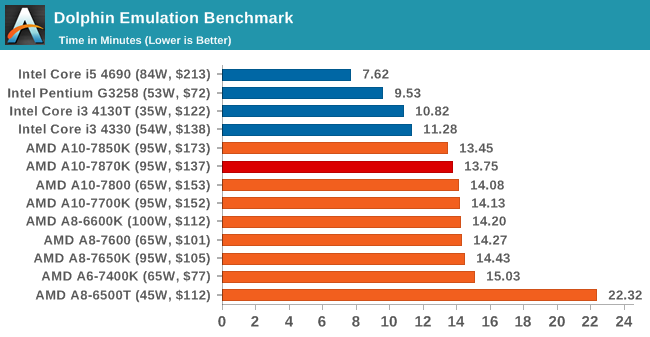
WinRAR 5.0.1: link
Our WinRAR test from 2013 is updated to the latest version of WinRAR at the start of 2014. We compress a set of 2867 files across 320 folders totaling 1.52 GB in size – 95% of these files are small typical website files, and the rest (90% of the size) are small 30 second 720p videos.
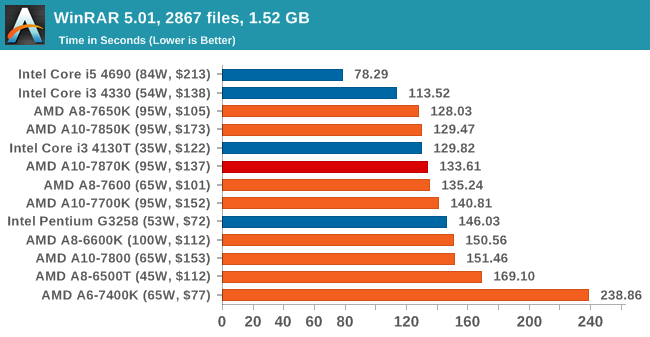
3D Particle Movement
3DPM is a self-penned benchmark, taking basic 3D movement algorithms used in Brownian Motion simulations and testing them for speed. High floating point performance, MHz and IPC wins in the single thread version, whereas the multithread version has to handle the threads and loves more cores.
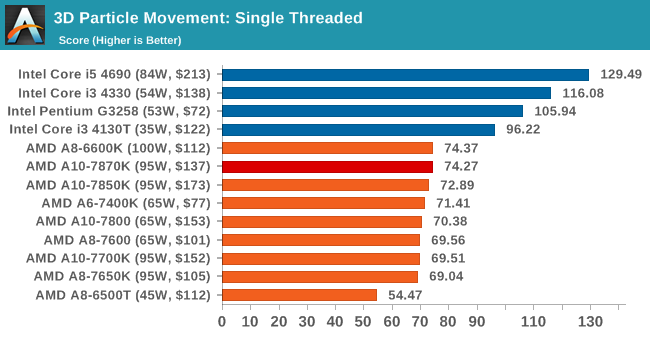
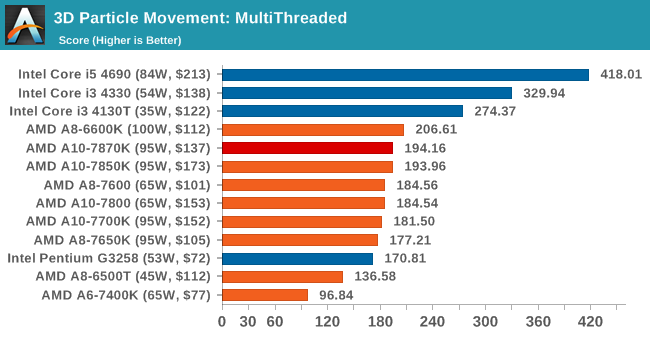
FastStone Image Viewer 4.9
FastStone is the program I use to perform quick or bulk actions on images, such as resizing, adjusting for color and cropping. In our test we take a series of 170 images in various sizes and formats and convert them all into 640x480 .gif files, maintaining the aspect ratio. FastStone does not use multithreading for this test, and results are given in seconds.
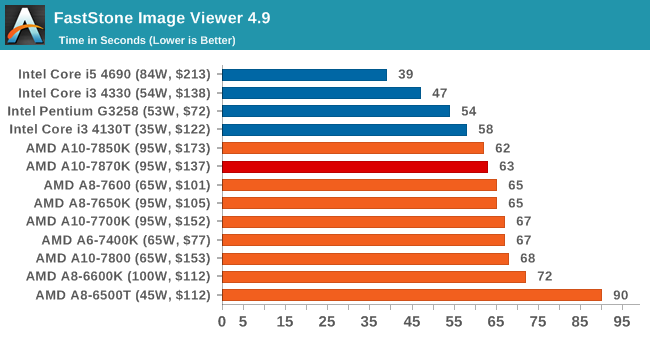
Web Benchmarks
On the lower end processors, general usability is a big factor of experience, especially as we move into the HTML5 era of web browsing. For our web benchmarks, we take four well known tests with Chrome 35 as a consistent browser.
Sunspider 1.0.2

Mozilla Kraken 1.1
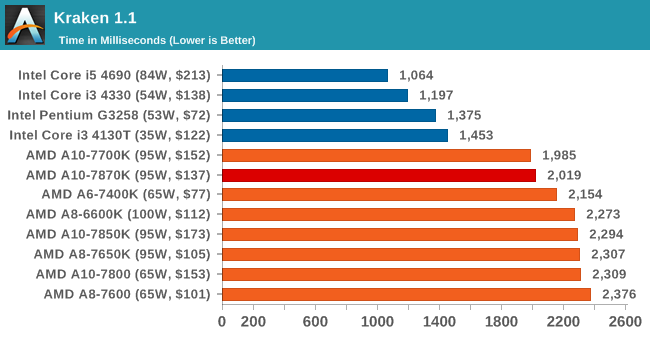
WebXPRT
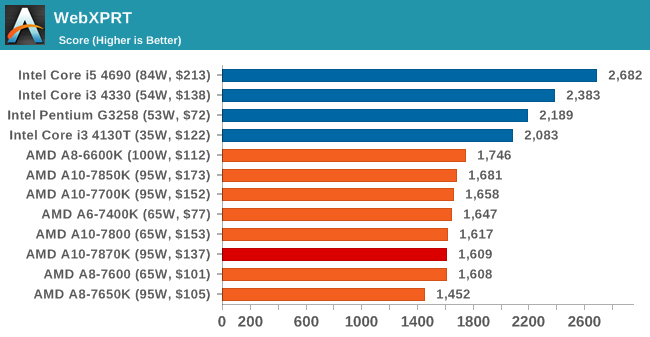
Google Octane v2
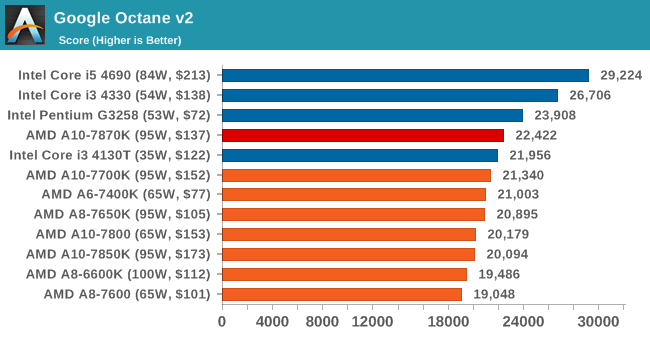










140 Comments
View All Comments
Jimster480 - Tuesday, June 2, 2015 - link
Although why would u want to go the Nvidia route if you have an APU? Why would you want to do dual vendor? The 750 isnt a good value so it only makes sense in applications that need to have a power sipping GPU.RussianSensation - Monday, June 1, 2015 - link
The suggestion of getting a stand-alone budget CPU and a GPU is sound but your recommendation for GTX750 is not. That line is garbage for games for the price.R9 270X costs $125 USD and is 44% faster than a GTX750Ti, which means > 50% faster than GTX750. If gaming is the primary consideration on a budget, under no circumstances should a budget gamer pick a 750/750Ti over the nearly 50% faster $125 270X:
http://www.newegg.com/Product/Product.aspx?Item=N8...
Benchmarks:
http://www.computerbase.de/2015-05/grafikkarten-17...
nikaldro - Monday, June 1, 2015 - link
I know that, but apparently the 260 and 270 line simply don't work well with intel dual cores, as digital foundry found out.meacupla - Monday, June 1, 2015 - link
After playing around with a Pentium G3258, I can clearly say that you're better off with 4 cores, even if 2 of them are virtual.There are now plenty of programs and games that will use up more than 1 thread.
nikaldro - Monday, June 1, 2015 - link
2 haswell cores are just as fast as 2 steamroller modules (wich, i remind, aren't really 4 actual "cores") in multithreaded tasks, and the pentium is MUCH better in single threaded tasks.As for the GPU, the 750 is way better than the APU's iGPU.
It's either a tie or a win for my combo in 90% of the situations.
meacupla - Monday, June 1, 2015 - link
You'll see. The issues with dual cores crop up when those two cores somehow get maxed out or one of them maxes out. 2 cores + 2 virtual cores just has better overhead when one of them gets maxed out.nikaldro - Monday, June 1, 2015 - link
An APU dooesn't have virtual cores. Maybe you are confusing their design with intel's hyperthreading.basically, an APU module is composed of 2 ALUs but only one FPU, so a dual module APU, like this one, does ok in ALU heavy workloads but just fails in FPU heavy ones.
And if a workload can "max out" 2 haswell cores, it sure as hell will kill 2 steamroller modules in almost all cases.
With the pentium you have equal multi thread performance and better single thread performance, as well as a better GPU.
Lolimaster - Monday, June 1, 2015 - link
Try crysis 3 on the pentium and the 870K, use the same dedicated gpu 750, 260, 980ti is you want. With just 2 cores youll get an stutter festival, IPC means nothing when the game actually demand core resources.nikaldro - Monday, June 1, 2015 - link
IPC IS core resources.If core count was all that mattered, we'd use ARM octacores.
silverblue - Tuesday, June 2, 2015 - link
...or AMD FX 8xxx CPUs. Sadly, reality is a mixture of IPC and core count.